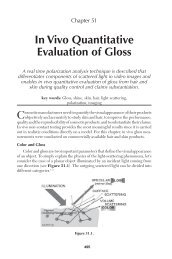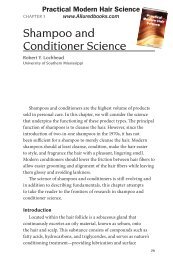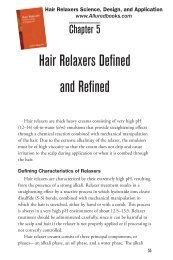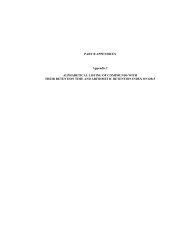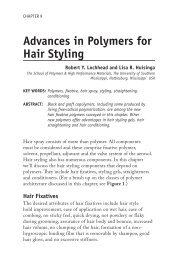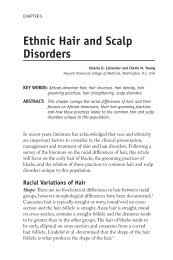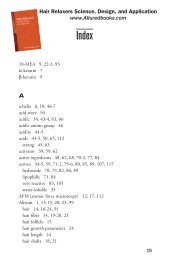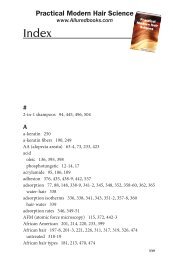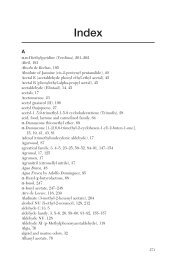A Diester to Protect Hair from Color Fade and ... - Alluredbooks.com
A Diester to Protect Hair from Color Fade and ... - Alluredbooks.com
A Diester to Protect Hair from Color Fade and ... - Alluredbooks.com
Create successful ePaper yourself
Turn your PDF publications into a flip-book with our unique Google optimized e-Paper software.
Chapter 35<br />
A <strong>Diester</strong> <strong>to</strong> <strong>Protect</strong> <strong>Hair</strong><br />
<strong>from</strong> <strong>Color</strong> <strong>Fade</strong> <strong>and</strong> Sun<br />
Damage<br />
Timothy Gao, PhD, Jung-Mei Tien, Abhijit Bidaye,<br />
Scott Cardinali <strong>and</strong> Jena Kinney<br />
Croda Inc., Edison, N.J., USA<br />
Key WorDS: diester, colorfade, tryp<strong>to</strong>phan degradation, hair fiber<br />
integrity, broad-spectrum UV filter<br />
ABSTrACT: A new broad-spectrum UV filter <strong>to</strong> protect hair <strong>from</strong><br />
color fading <strong>and</strong> integrity damage, quaternium-95 (<strong>and</strong>)<br />
propanediol, has been developed for rinse-off formulations.<br />
Shampoos <strong>and</strong> conditioners containing this material<br />
protected dyed hair against surface tryp<strong>to</strong>phan degradation<br />
<strong>and</strong> tensile strength reduction.<br />
Like skin, hair is susceptible <strong>to</strong> damage <strong>from</strong> exposure <strong>to</strong> the sun.<br />
This damage affects its aesthetics <strong>and</strong> mechanical <strong>and</strong> physical<br />
properties, resulting in dull, flat hair. Research indicates that both<br />
UVA <strong>and</strong> UVB radiation are responsible for this damage. Hoting, 1<br />
for example, studied hair tresses dyed red by exposing them <strong>to</strong> UVA<br />
<strong>and</strong> UVB radiation, finding that the tresses underwent more fading<br />
after UVA irradiation. Artificial hair color based on pyrazole intermediates<br />
also has shown significant fading after shampoo washing<br />
<strong>and</strong> UV exposure. 2 Hoting thus concluded that exposure <strong>to</strong> UVA<br />
radiation resulted in a significant <strong>and</strong> perceivable change in the dyed<br />
red hair color. According <strong>to</strong> his research, the red pigment introduced<br />
in<strong>to</strong> the hair fiber by the dyeing process acts as a pho<strong>to</strong>recep<strong>to</strong>r,<br />
absorbing pho<strong>to</strong>ns <strong>and</strong> pho<strong>to</strong>chemically degrading after UVA <strong>and</strong><br />
visible light irradiation.
416<br />
Chapter 35 Gao et al.<br />
The effects of UVB radiation on hair also can be severe, resulting<br />
in the breakdown of disulfide bonds both inside the hair fiber <strong>and</strong><br />
on the surface of the cuticle. 3 Such disruptions <strong>to</strong> the disulfide linkages<br />
of the hair fiber can have a major impact on hair’s mechanical<br />
properties, resulting in the loss of tensile strength <strong>and</strong> an increase in<br />
porosity <strong>and</strong> irregularities on the hair surface.<br />
To protect hair <strong>from</strong> UV damage, UV filters deposited on the<br />
hair surface absorb incident UV light. As noted, since both UVA<br />
<strong>and</strong> UVB radiation cause severe <strong>and</strong> perceivable damage, broadspectrum<br />
UV absorbers provide the best protection <strong>from</strong> fading <strong>and</strong><br />
sun damage. In addition <strong>to</strong> broad spectrum coverage, deposition <strong>and</strong><br />
absorption on<strong>to</strong> the hair surface are crucial fac<strong>to</strong>rs <strong>to</strong> consider when<br />
designing materials for rinse-off systems.<br />
Figure 35.1. absorption spectrum of the diester solution<br />
In the present chapter, the authors introduce a quaternized<br />
diester a designed <strong>to</strong> provide broad-spectrum protection <strong>to</strong> hair in<br />
rinse-off systems. An absorption spectrum of the diester solution<br />
(20.0 mg/L active in SDA-40), shown in Figure 35.1, ranges <strong>from</strong><br />
the UVB region (280–320 nm) <strong>to</strong> the UVA region (320–400 nm).<br />
The absorption peak, located at 310 nm, falls within the UVA region,<br />
thus researchers concluded the material should provide efficacious<br />
a Chromaveil (INCI: Quaternium-95 (<strong>and</strong>) propanediol) is a product of Croda Inc.
417<br />
A <strong>Diester</strong> <strong>to</strong> <strong>Protect</strong> <strong>Hair</strong> <strong>from</strong> <strong>Color</strong> <strong>Fade</strong> <strong>and</strong> Sun Damage<br />
color protection for dyed hair. Additional studies (data not shown)<br />
examined the material’s stability after five days of UV exposure,<br />
showing no change in absorbance or net weight for the diester.<br />
Thus, further studies were warranted <strong>to</strong> examine its ability<br />
<strong>to</strong> protect hair fibers <strong>from</strong> cuticle damage <strong>and</strong> reduced tensile<br />
strength resulting <strong>from</strong> degradation of tryp<strong>to</strong>phan <strong>and</strong> proteins on<br />
the hair surface <strong>and</strong> inside the hair fiber. The ability of the diester<br />
<strong>to</strong> protect hair <strong>from</strong> colorfade in the presence of UV radiation also<br />
was examined.<br />
Materials <strong>and</strong> Methods<br />
Various pro<strong>to</strong>cols were used <strong>to</strong> evaluate the diester’s ability <strong>to</strong><br />
protect hair fibers <strong>from</strong> UV damage. Bleached European brown<br />
hair tresses were dyed with either a <strong>com</strong>mercially available medium<br />
brown hair color or medium auburn color for 30 min following the<br />
instructions provided in color kits. For testing of UVB damage,<br />
virgin dark brown hair was used. Some tresses were treated with<br />
control <strong>and</strong> diester-containing shampoos <strong>and</strong> conditioners (see Formulas<br />
1 <strong>and</strong> 2). A subset of treated tresses were then irradiated b for<br />
3 hr on each side, <strong>to</strong>taling 6 hr-equivalent <strong>to</strong> one day of UV exposure<br />
4 -with UV radiation (200–400 nm) at 50 W/m 1 using a quartz<br />
inner filter <strong>and</strong> type “s” borosilicate outer filter. At the start of the<br />
study <strong>and</strong> at intervals equivalent <strong>to</strong> every five days of UV exposuree.g.,<br />
after every 30 hrs-tresses were treated again with control <strong>and</strong><br />
diester-containing shampoos <strong>and</strong> conditioners. Irradiated tresses<br />
were exposed <strong>to</strong> the <strong>to</strong>tal equivalent of 15 days of UV exposure. Test<br />
conditions were maintained at 40°C <strong>and</strong> 65% relative humidity.<br />
Different types of tresses were <strong>com</strong>pared, including those that<br />
were dyed <strong>and</strong> not exposed <strong>to</strong> treatment or UV exposure; dyed <strong>and</strong><br />
treated with the control shampoos <strong>and</strong> conditioners <strong>and</strong> exposed<br />
<strong>to</strong> UV; <strong>and</strong> dyed <strong>and</strong> treated with shampoos <strong>and</strong> conditioners containing<br />
the diester <strong>and</strong> exposed <strong>to</strong> UV. Comparative color loss was<br />
determined both objectively <strong>and</strong> subjectively. The <strong>to</strong>tal color loss<br />
(∆E) was calculated by assessing the changes in L*, a*, b* readings<br />
b the atlas Ci300+ Xenon Weather-Ometer is a product of atlas Material testing Solutions,<br />
International hair Importers
418<br />
Chapter 35 Gao et al.<br />
on the treated tresses using a spectrocolorimeter c . The equation<br />
used <strong>to</strong> calculate the <strong>to</strong>tal color loss was:<br />
∆E = [(∆L) 2 + (∆a) 2 + (∆b) 2 ] 1/2<br />
Formula 1. Shampoo test formulations<br />
Ingredient Control <strong>Diester</strong> Shampoo<br />
Sodium laureth sulfate 35.00% w/w 35.00% w/w<br />
Cocamidopropyl betaine 10.00 10.00<br />
Quaternium-95 (<strong>and</strong>) propanediol, 75%<br />
active (ChromaVeil, Croda) --- 2.00<br />
peG-150 pentaerythrityl tetrastearate<br />
(<strong>and</strong>) peG-6 caprylic/capric glycerides<br />
(<strong>and</strong>) water (aqua) --- 2.80<br />
Water (aqua) 55.00 50.20<br />
100.00 100.00<br />
Formula 2. Conditioner test formulations<br />
Ingredient Control <strong>Diester</strong><br />
Conditioner Conditioner<br />
Quaternium-91 (<strong>and</strong>) cetrimonium<br />
methosulfate (<strong>and</strong>) cetearyl alcohol 2.14% w/w 2.14% w/w<br />
Cetearyl alcohol 3.86 3.86<br />
Quaternium-95 (<strong>and</strong>) propanediol, 75% active<br />
(ChromaVeil, Croda) --- 2.00<br />
phenoxyethanol (<strong>and</strong>) methylparaben<br />
(<strong>and</strong>) ethylparaben (<strong>and</strong>) butylparaben<br />
(<strong>and</strong>) propylparaben (<strong>and</strong>)<br />
isobutylparaben (phenonip, Clariant) 1.00 1.00<br />
Water (aqua) 93.00 91.00<br />
100.00 100.00<br />
The changes in hair color indexes were calculated using the<br />
respective values after the shampoo <strong>and</strong> conditioner treatments<br />
<strong>and</strong> before UV exposure; <strong>and</strong> after the equivalent of 15 days of UV<br />
c LabScan Xe Spectrocolorimeter is a product of hunterLab.
419<br />
A <strong>Diester</strong> <strong>to</strong> <strong>Protect</strong> <strong>Hair</strong> <strong>from</strong> <strong>Color</strong> <strong>Fade</strong> <strong>and</strong> Sun Damage<br />
exposure. The results of the instrumental evaluations were confirmed<br />
via subjective testing. The swatches were pho<strong>to</strong>graphed <strong>and</strong> <strong>com</strong>pared<br />
<strong>to</strong> dyed but untreated swatches, which represent the initial dye<br />
color, <strong>to</strong> allow for visual <strong>com</strong>parisons. Panelists were also asked <strong>to</strong><br />
rate the color protection effects in simple <strong>com</strong>parisons of the control<br />
<strong>and</strong> the diester swatches <strong>to</strong> the untreated control.<br />
To determine the amount of damage on the hair fiber due <strong>to</strong> the<br />
UVB irradiation, several parameters of the hair fiber were measured.<br />
As noted, UV exposure <strong>to</strong> hair can break down the disulfide bonds<br />
in the hair fiber. Tryp<strong>to</strong>phan is a key amino acid found on the hair<br />
surface <strong>and</strong> it de<strong>com</strong>poses under UVB irradiation. 2<br />
Surface tryp<strong>to</strong>phan degradation is thus an indica<strong>to</strong>r of damage<br />
<strong>to</strong> the disulfide bonds <strong>and</strong> it can be quantified through <strong>com</strong>parative<br />
fluorescence intensities of hair tresses using a spectrofluorometer d .<br />
The excitation wavelength was set at 295 nm <strong>and</strong> the tryp<strong>to</strong>phan<br />
emission intensity was measured at 340 nm. The emission intensity<br />
was assumed <strong>to</strong> be directly proportional <strong>to</strong> the surface tryp<strong>to</strong>phan<br />
concentration.<br />
Using surface tryp<strong>to</strong>phan intensities of the hair sample before<br />
UV exposure as the baseline, the tryp<strong>to</strong>phan protection fac<strong>to</strong>rs of<br />
hair samples treated with diester shampoo or the control shampoo<br />
after UV exposure can be calculated using the equation:<br />
F (Tr) = [I f / I o ] X 100%<br />
In this equation, F(Tr) is the tryp<strong>to</strong>phan protection fac<strong>to</strong>r,<br />
calculated as a percentage; I f is the surface tryp<strong>to</strong>phan fluorescence<br />
intensity of the hair sample after UV exposure; <strong>and</strong> I o is the surface<br />
tryp<strong>to</strong>phan fluorescence intensity of the same hair sample before<br />
UV exposure.<br />
UVB rays not only de<strong>com</strong>pose the surface tryp<strong>to</strong>phan but also<br />
penetrate the hair cuticle <strong>and</strong> cause damage inside the cortex. This<br />
damage affects hair’s mechanical properties <strong>and</strong> can be measured in<br />
terms of its tensile strength (stress-<strong>to</strong>-break). Using a tensile tester e ,<br />
the tensile strength of single fibers <strong>from</strong> the treated tresses was<br />
measured before <strong>and</strong> after UV exposure.<br />
d Spex FluoroLog-3 is a instrument manufactured by horiba Jobin Yvon.<br />
e Miniature tensile tester (Mtt) 670 is a product of Dia-Stron Ltd.
420<br />
Chapter 35 Gao et al.<br />
To test the ability of the diester <strong>to</strong> protect hair fibers in rinse-off<br />
systems, a shampoo <strong>and</strong> conditioner were formulated with <strong>and</strong> without<br />
the diester (see Formulas 1 <strong>and</strong> 2).<br />
UV <strong>Protect</strong>ion with <strong>Diester</strong><br />
UVA protection in shampoo: Auburn-colored tresses were treated<br />
with the control <strong>and</strong> diester shampoo <strong>and</strong> exposed <strong>to</strong> 15 equivalent<br />
days of UV exposure (see Figure 35.2). The treated tresses were<br />
visually <strong>com</strong>pared <strong>to</strong> one another <strong>and</strong> <strong>to</strong> a dyed tress that was not<br />
exposed <strong>to</strong> UV irradiation (Figure 35.2a). The tresses treated with<br />
the control shampoo (Figure 35.2b-c) lost a significant amount of<br />
color while the hair tresses washed with the shampoo containing the<br />
diester (Figure 35.2d-e) showed less color fade. The <strong>to</strong>tal color loss<br />
(∆E) of the tresses treated with the shampoos was also assessed after<br />
15 days of UV exposure. Tresses that demonstrated better color protection<br />
had a smaller ∆E. The quantitative color loss data confirms<br />
what the visual assessment illustrates—that the shampoo containing<br />
the diester had a significantly smaller ∆E, <strong>and</strong> the diester-treated<br />
tress maintained more color. The diester thus demonstrates color<br />
protection with a ∆E of 10.5, <strong>com</strong>pared <strong>to</strong> the control shampoo<br />
with a ∆E of 12.4, a difference of almost 2 units (see Figure 35.3).<br />
To confirm the correlation between visual inspection of images,<br />
color index measurement <strong>and</strong> consumer perception, 17 panelists<br />
selected the tresses they thought had the most <strong>and</strong> least change in<br />
color after tresses were exposed <strong>to</strong> 15 days of UV. Subjective evaluation<br />
results indicated that 100% of the panelists perceived that<br />
the diester shampoo gave superior color protection on the medium<br />
auburn treated hair (data not shown).<br />
A similar study was performed with the shampoos on hair dyed<br />
with medium brown color. The tresses shown in Figure 35.4 were<br />
treated with the control <strong>and</strong> diester shampoo. <strong>Hair</strong> tresses washed<br />
with the diester shampoo (Figure 35.4e-f) showed less color fade<br />
than the control shampoo (Figure 35.4c-d). The left two tresses<br />
were dyed <strong>and</strong> not exposed <strong>to</strong> UV (Figure 35.4a-b), <strong>to</strong> serve as a<br />
reference.<br />
Figure 35.5 shows the quantitative ∆E <strong>to</strong>tal color changes of<br />
hair tresses colored medium brown that were treated with both<br />
shampoos <strong>and</strong> exposed <strong>to</strong> 15 days of UV exposure. <strong>Hair</strong> tresses
421<br />
A <strong>Diester</strong> <strong>to</strong> <strong>Protect</strong> <strong>Hair</strong> <strong>from</strong> <strong>Color</strong> <strong>Fade</strong> <strong>and</strong> Sun Damage<br />
treated with the diester shampoo showed less <strong>to</strong>tal color change,<br />
almost 3 units, than the control shampoo, indicating the diester<br />
shampoo provided better color protection.<br />
Figure 35.2. effects of the diester vs. control shampoo on medium auburn hair<br />
Figure 35.3. <strong>to</strong>tal color changes of medium auburn-colored hair treated with different<br />
shampoos after 15 days of UV exposure
422<br />
Chapter 35 Gao et al.<br />
Again, the panel evaluation demonstrated a strong correlation<br />
between the visual results <strong>and</strong> the instrumental results. On medium<br />
brown hair, 94.1% of panelists chose the tresses treated with the<br />
diester shampoo as having retained the most color.<br />
Figure 35.4. effects of the diester vs. control shampoo on medium brown hair<br />
Figure 35.5. <strong>to</strong>tal color change of medium brown-colored hair treated with different<br />
shampoos after 15 days of UV exposure
423<br />
A <strong>Diester</strong> <strong>to</strong> <strong>Protect</strong> <strong>Hair</strong> <strong>from</strong> <strong>Color</strong> <strong>Fade</strong> <strong>and</strong> Sun Damage<br />
UVA protection <strong>from</strong> a conditioner: Another set of auburn-colored<br />
tresses was treated with a rinse-off conditioner containing the<br />
diester (Formula 2) <strong>and</strong> the same conditioner without the UV filter<br />
<strong>to</strong> serve as a control. Figure 35.6 shows that hair tresses washed<br />
with the diester conditioner (Figure 35.6d-e) showed less colorfade<br />
on auburn-colored hair than the control conditioner (Figure 35.6bc).<br />
The left tress was dyed but not exposed <strong>to</strong> UV radiation (Figure<br />
35.6a) <strong>to</strong> serve as a reference.<br />
Figure 35.6. effects of the diester vs. control conditioner for medium auburn color<br />
Although not as definitive as the shampoo studies, 64.7% of the<br />
panelists preferred the diester conditioner on auburn-colored hair.<br />
UVB protection <strong>from</strong> a shampoo: To assess for surface tryp<strong>to</strong>phan<br />
damage, the surface fluorescence intensities of virgin brown tresses<br />
treated with either the control or diester shampoo were determined<br />
after 15 equivalent days of UV irradiation (see Figure 35.7) <strong>and</strong><br />
<strong>com</strong>pared <strong>to</strong> the fluorescence intensities of the hair before UV<br />
exposure.<br />
The shampoo containing the diester showed 97.48% tryp<strong>to</strong>phan<br />
protection after the 15 equivalent days of exposure, while the control
424<br />
Chapter 35 Gao et al.<br />
shampoo showed 91.42% tryp<strong>to</strong>phan protection. The addition of the<br />
diester <strong>to</strong> the shampoo improved the protection against degradation<br />
of amino acids in the hair fiber. The tryp<strong>to</strong>phan degradation testing<br />
was not performed on the conditioner series; however, researchers<br />
anticipate similar results would be seen.<br />
Figure 35.7. Change in tryp<strong>to</strong>phan intensity after UV exposure <strong>and</strong> treatment with diester<br />
shampoo<br />
Testing UVB <strong>Protect</strong>ion with Tensile Strength<br />
Fibers showing a decrease in stress-<strong>to</strong>-break forces after UV exposure<br />
have undergone a loss in mechanical strength primarily due <strong>to</strong><br />
the breaking of disulfide bonds inside the hair cortex. A <strong>com</strong>parison<br />
of the tensile strength of virgin brown hair treated with the diester<br />
shampoo was made <strong>to</strong> hair similarly treated with the control rinseoff<br />
product. Note that disulfide bonds inside the cortex have been<br />
broken in the tresses treated with the control shampoo, while tresses<br />
treated with the diester have no disulfide bond breakage (see Figure<br />
35.8). The diester shampoo protected the hair <strong>from</strong> UVB damage<br />
<strong>and</strong> preserved the hair’s natural strength.<br />
Using the same methodology, virgin brown hair tresses were<br />
treated with the control <strong>and</strong> diester conditioner, respectively, for<br />
tensile strength measurements. The diester conditioner also provided<br />
protection against damage <strong>to</strong> the fiber (see Figure 35.9).
425<br />
A <strong>Diester</strong> <strong>to</strong> <strong>Protect</strong> <strong>Hair</strong> <strong>from</strong> <strong>Color</strong> <strong>Fade</strong> <strong>and</strong> Sun Damage<br />
Figure 35.8. Change in tensile strength after UV exposure <strong>and</strong> treatment with shampoos<br />
Figure 35.9. Change in tensile strength after UV exposure <strong>and</strong> treatment with conditioners<br />
Conclusions<br />
While protection of hair <strong>from</strong> the sun is not a new concept, technology<br />
continues <strong>to</strong> improve <strong>to</strong> offer consumers better protection as<br />
part of their daily regimen. As shown, the diester is substantive <strong>to</strong>
426<br />
Chapter 35 Gao et al.<br />
the hair <strong>and</strong> offers broad-spectrum protection in rinse-off systems.<br />
Although the diester has not yet been tested in leave-in systems, the<br />
authors expect the diester <strong>to</strong> provide good hair protection.<br />
The addition of the diester in wash-off systems provides protection<br />
against UVA-induced colorfade as well as protection <strong>from</strong><br />
UVB-induced disulfide bond breakage that manifests as a loss of<br />
hair strength. The diester also protects <strong>from</strong> the degradation of<br />
amino acids on the hair surface. This broad-spectrum protection<br />
gives consumers the freedom <strong>to</strong> enjoy the sun without the concern<br />
for hair damage. In addition, it offers protection for artificial hair<br />
color <strong>and</strong> fiber integrity.<br />
Published May 2009 Cosmetics & Toiletries magazine<br />
references<br />
1. E Hoting, Sunlight-induced modifications in bleached, permed, or dyed human hair, J Soc<br />
Cosmet Chem, 48 79–91 (Mar/Apr 1997)<br />
2. B Locke <strong>and</strong> J Jachowicz, Fading of artificial hair color <strong>and</strong> its prevention by pho<strong>to</strong>filters,<br />
J Cosmet Sci, 56 407–425 (2005)<br />
3. T Gao <strong>and</strong> A Bedell, UV damage on natural gray hair <strong>and</strong> its pho<strong>to</strong>protection, J Soc<br />
Cosmet Chem, 52 103–118 (Mar/Apr 2001)<br />
4. M Jeanmougin <strong>and</strong> J Civatte, Dosimetrtrie du rayonnement UV solaire, Ann Derma<strong>to</strong>l<br />
Venerol, 114 671–676 (1987)



